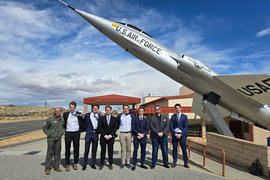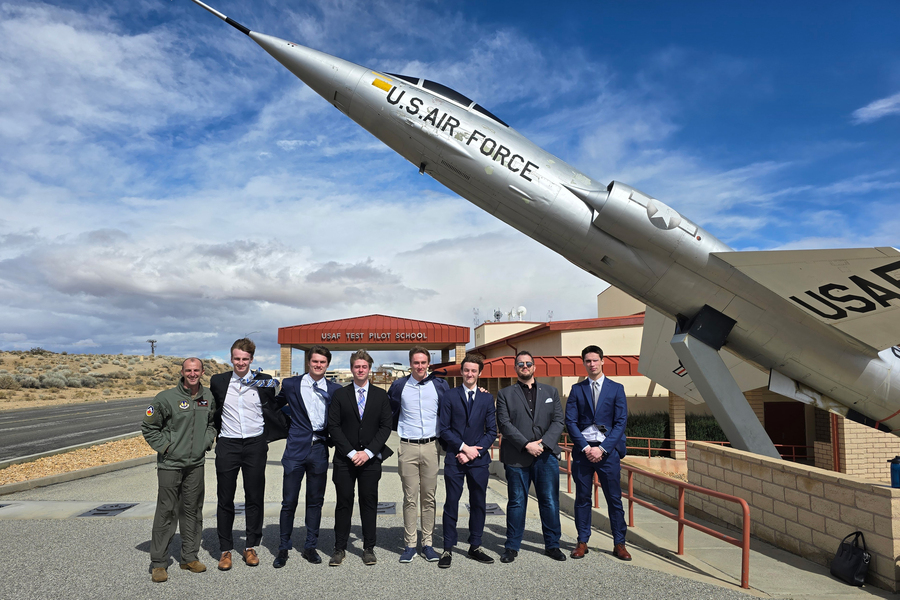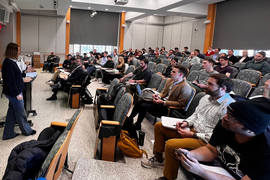Startups and government defense agencies have historically seemed like polar opposites. Startups thrive on speed and risk, while defense agencies are more cautious. Over the past few years, however, things have changed. Many startups are eager to work with these organizations, which are always looking for innovative solutions to their hardest problems.
To help bridge that gap while advancing research along the way, MIT Lecturer Gene Keselman launched MIT’s Mission Innovation X (MIx) along with Sertac Karaman, a professor in the MIT Department of Aeronautics and Astronautics, and Fiona Murray, the William Porter Professor of Entrepreneurship at the MIT Sloan School of Management. MIx develops educational programming, supports research at MIT, and facilitates connections among government organizations, startups, and researchers.
“Startups know how to commercialize their tech, but they don’t necessarily know how to work with the government, and especially how to understand the needs of defense customers,” explains MIx Senior Program Manager Keenan Blatt. “There are a lot of different challenges when it comes to engaging with defense, not only from a procurement cycle and timeline perspective, but also from a culture perspective.”
MIx’s work helps innovators secure crucial early funding while giving defense agencies access to cutting-edge technologies, boosting America’s security capabilities in the process. Through the work, MIx has also become a thought leader in the emerging “dual-use” space, in which researchers and founders make strategic choices to advance technologies that have both civilian and defense applications.
Gene Keselman, the executive director of MIx as well as managing director of MIT’s venture studio Proto Ventures and a colonel in the U.S. Air Force Reserve, believes MIT is uniquely positioned to deliver on MIx’s mission.
“It’s not a coincidence MIx is happening at MIT,” says Keselman, adding that supporting national security “is part of MIT’s ethos.”
A history of service
MIx’s work has deep roots at the Institute.
“MIT has worked with the Department of Defense since at least since the 1940s, but really going back to its founding years,” says Karaman, who is also the director of MIT’s Laboratory for Information and Decision Systems (LIDS), a research group with its own long history of working with the government.
“The difference today,” adds Murray, who teaches courses on building deep tech ventures and regional innovation ecosystems and is the vice chair of NATO's Innovation Fund, “is that defense departments and others looking to support the defense, security, and resilience agenda are looking to several innovation ecosystem stakeholders — universities, startup ventures, and venture capitalists — for solutions. Not only from the large prime contractors. We have learned this lesson from Ukraine, but the same ecosystem logic is at the core of our MIx offer.”
MIx was borne out of the MIT Innovation Initiative in response to interest Keselman saw from researchers and defense officials in expanding MIT’s work with the defense and global security communities. About seven years ago, he hired Katie Person, who left MIT last year to become a battalion commander, to handle all that interest as a program manager with the initiative. MIx activities, like mentoring and educating founders, began shortly after, and MIx officially launched at MIT in 2021.
“It was a good example of the ways in which MIT responds to its students’ interests and external demand,” Keselman says.
One source of early interest was from startup founders who wanted to know how to work with the defense industry and commercialize technology that could have dual commercial and defense applications. That led the team to launch the Dual Use Ventures course, which helps startup founders and other innovators work with defense agencies. The course has since been offered annually during MIT’s Independent Activities Period (IAP) and tailored for NATO’s Defense Innovation Accelerator for the North Atlantic (DIANA).
Personnel from agencies including U.S. Special Operations Command were also interested in working with MIT students, which led the MIx team to develop course 15.362/6.9160 (Engineering Innovation: Global Security Systems), which is taken each spring by students across MIT and Harvard University.
“There are the government organizations that want to be more innovative and work with startups, and there are startups that want to get access to funding from government and have government as a customer,” Keselman says. “We’re kind of the middle layer, facilitating connections, educating, and partnering on research.”
MIx research activities give student and graduate researchers opportunities to work on pressing problems in the real world, and the MIT community has responded eagerly: More than 150 students applied for MIx’s openings in this summer’s Undergraduate Research Opportunities Program.
"We’re helping push the boundaries of what’s possible and explore the frontiers of technology, but do it in a way that is publishable," says MIx Head Research Scientist A.J. Perez ’13, MEng ’14, PhD ’23. “More broadly, we want to unlock as much support for students and researchers at MIT as possible to work on problems that we know matter to defense agencies.”
Early wins
Some of MIx’s most impactful research so far has come in partnership with startups. For example, MIx helped the startup Picogrid secure a small business grant from the U.S. Air Force to build an early wildfire detection system. As part of the grant, MIT students built a computer vision model for Picogrid’s devices that can detect smoke in the sky, proving the technical feasibility of the system and describing a promising new pathway in the field of machine learning.
In another recent project with the MIT alumni-founded startup Nominal, MIT students helped improve and automate post-flight data analysis for the U.S. Air Force’s Test Pilot School.
MIx’s work connecting MIT’s innovators and the wider innovation ecosystem with defense agencies has already begun to bear fruit, and many members of MIx believe early collaborations are a sign of things to come.
“We haven’t even scratched the surface of the potential for MIx,” says Karaman, “This could be the start of something much bigger.”









